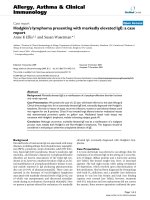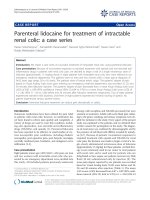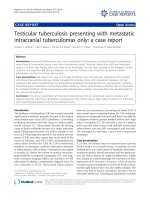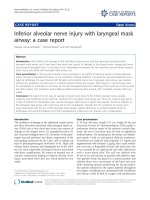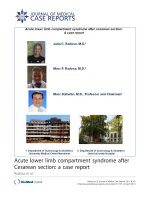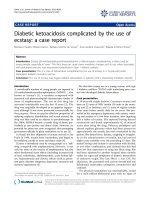Báo cáo y học: "Death following bilateral complete Achilles tendon rupture in a patient on fluoroquinolone therapy: a case report" pps
Bạn đang xem bản rút gọn của tài liệu. Xem và tải ngay bản đầy đủ của tài liệu tại đây (220.31 KB, 4 trang )
BioMed Central
Page 1 of 4
(page number not for citation purposes)
Journal of Medical Case Reports
Open Access
Case report
Death following bilateral complete Achilles tendon rupture in a
patient on fluoroquinolone therapy: a case report
Andrew W Gottschalk* and John W Bachman
Address: Mayo Clinic, Department of Family Medicine, 1st Street SW, Rochester, MN 55905, USA
Email: Andrew W Gottschalk* - ; John W Bachman -
* Corresponding author
Abstract
Introduction: Risk of tendon rupture, especially of the Achilles tendon, is one of the many
potential side-effects of fluoroquinolone therapy. Achilles tendon rupture may be painful,
debilitating or, as seen in our patient, devastating. While fluoroquinolone-induced tendon rupture
typically accompanies other comorbidities (for example renal impairment) or concurrent steroid
therapy, our case represents a medical 'first' in that there were no such comorbidities and no
steroid therapy. Furthermore, our case is remarkable in that tendon rupture was bilateral,
complete, and resulted in a devastating outcome.
Case presentation: A healthy 91-year-old Caucasian man was placed on fluoroquinolone
(levofloxacin) therapy for a presumed bacterial pneumonitis. Subsequently, he developed bilateral
heel pain, edema, and ecchymoses leading to a diagnosis of bilateral complete Achilles tendon
rupture. This drug's side-effect was directly responsible for his subsequent physical and psychologic
decline and unfortunate death.
Conclusion: Fluoroquinolones are a powerful and potent tool in the fight against bacterial
infection. As a class, they are employed by primary care physicians as well as by subspecialty
physicians in all areas of medical practice. However, as this case illustrates, the use of these drugs
is not without risk. Attention must be paid to potential side-effects when prescribing any
medication, and close follow-up with patients is a medical necessity to evaluate for these adverse
reactions, especially with fluoroquinolones.
Introduction
Fluoroquinolones treat a broad spectrum of both Gram-
positive and Gram-negative organisms, have high enteral
bioavailability, and are renally excreted. Fluoroquinolo-
nes are effective in respiratory, urinary, and gastrointesti-
nal tract infections. Furthermore, their rapid
accumulation in bone and cartilage makes them a conven-
ient and effective therapy in the field of orthopedics [1].
For all of these reasons, fluoroquinolones are an attractive
antimicrobial choice of treatment among healthcare pro-
viders in most fields of medical practice.
However, the treatment is not without its cost. Fluoroqui-
nolone accumulation in developing joints has raised con-
cerns based on studies of laboratory animals on the
potential for cartilage erosion and subsequent arthropa-
thy. They are therefore contraindicated in obstetric
patients, breastfeeding mothers, and in pediatric patients
Published: 6 January 2009
Journal of Medical Case Reports 2009, 3:1 doi:10.1186/1752-1947-3-1
Received: 14 August 2008
Accepted: 6 January 2009
This article is available from: />© 2009 Gottschalk and Bachman; licensee BioMed Central Ltd.
This is an Open Access article distributed under the terms of the Creative Commons Attribution License ( />),
which permits unrestricted use, distribution, and reproduction in any medium, provided the original work is properly cited.
Journal of Medical Case Reports 2009, 3:1 />Page 2 of 4
(page number not for citation purposes)
younger than 18 years old. Side-effects from fluoroqui-
nolone use include arrhythmias, hypoglycemia, pancyto-
penias, hepatitis, polyneuropathies, and acute renal
failure [2,3]. Another side-effect of concern is tendinopa-
thy, with ciprofloxacin, norfloxacin, ofloxacin, and levo-
floxacin having associations that have been reported in
the literature [1,4-7]. Tendinopathy subsequent to fluoro-
quinolone treatment, typically classified as tendonitis
(inflammatory) or tendinosis (microtears), has an inci-
dence of 2.4 per 10 000 patients. Partial Achilles tendon
rupture is rarer still, at 1.2 per 10 000 [8]. However, nei-
ther complete tendon rupture nor bilateral tendon rup-
ture occur often enough to have a calculated incidence in
fluoroquinolone-treated patients; rarer still are the two
conditions occurring together.
Case presentation
A 91-year-old Caucasian male farmer presented at the
Mayo Clinic, Rochester, Minnesota for evaluation of the
acute complaint, "My feet aren't working." Specifically, he
reported difficulty with balance leading to inability to
walk, and extensive, painful bilateral ecchymoses of his
heels (Figures 1 and 2). His distress and instability were
alleviated only modestly by the use of a non-prescription
cane. Barefoot ambulation was impossible. Barely func-
tional ambulation was accomplished by wearing hard-
soled shoes.
One month prior, the patient had been diagnosed with
bronchitis at an outside clinic and was treated with a
seven-day course of levofloxacin 500 mg by mouth, taken
once a day (his estimated creatinine clearance was 32 mL/
min using the Cockcroft-Gault equation). His bilateral
heel pain developed insidiously over the first four days of
fluoroquinolone treatment.
Even at 91, the patient had led an active lifestyle on his
farm. He cooked all of his own meals, drove a tractor, and
performed many other physical farm chores. On day
seven of treatment, upon dismounting his tractor, he
noticed sudden, severe pain in both of his heels and a
compromised ability to ambulate independently.
The patient's medical history was otherwise notable for a
mitral valve replacement with porcine xenograft 25 years
prior, chronic hypertension, hyperlipidemia, degenerative
spondylosis, depression and gastroesophageal reflux dis-
ease (GERD). He had no history of tendinopathy. The
patient had never smoked, and had no exposure to sec-
ond-hand smoke. He reported alcohol ingestion of two
beers per month and caffeine consumption of three 8 oz
cups of coffee per day.
In addition to the levofloxacin, the patient was on the fol-
lowing medications, with no recent changes: metoprolol
ER 100 mg/d, isosorbide mononitrate ER 60 mg/d, hydro-
chlorothiazide/triamterene 25 mg/37.5 mg/d, spironolac-
tone/hydrochlorothiazide 25 mg/25 mg/d, quinapril 20
mg/d, celecoxib 200 mg/d, glucosamine 1500 mg/d, ser-
traline 100 mg/d, omeprazole 20 mg/d, and acetami-
nophen 1000 mg every six hours as needed for arthritis-
related pain. He had no known food or medication aller-
gies.
On presentation to the hospital, the patient was afebrile
and all vital signs were stable. Both heels were mildly ede-
matous with overlying ecchymoses and were tender to
palpation bilaterally. The patient had a palpable gap and
mass-like defect distally with palpation along the left
Achilles tendon. There was a similar gap, although no pal-
pable mass defect, on the right. Dorsalis pedis and poste-
rior tibial pulses were 2+ bilaterally, and capillary refill
was less than two seconds in the great toes bilaterally.
Thompson's test (also known as Simmond's sign) was
abnormal bilaterally, with no movement of either foot.
The patient could barely raise himself up on his tiptoes. In
T2-weighted image of the patient's left heelFigure 1
T2-weighted image of the patient's left heel. MRI
machines measure proton density; density is proportional to
how dark a tissue appears on the scan. 'T1' and 'T2' are tech-
nical terms describing the time required for proton relaxa-
tion. T2 images make adipose tissue, water, and other fluids
bright, thus these images are ideal for detecting tissue edema.
On the image, note the intact flexor hallucis longus (filled
arrowheads) pulled taught. The flexor hallucis longus is
responsible for what little plantar flexion the patient had left.
The arrows show the retracted and limp proximal end of the
Achilles tendon, with the bright area of signal intensity (open
arrowhead) representing inflammation and fluid migration
between the severed ends.
Journal of Medical Case Reports 2009, 3:1 />Page 3 of 4
(page number not for citation purposes)
both lower extremities, ankle plantar flexion strength was
3/5, great toe flexion to test the flexor hallucis longus was
5/5, and ankle dorsiflexion to test the extensor hallucis
longus was 5/5. The patient maintained full active and
passive knee range of motion bilaterally. He demon-
strated antalgic gait with significant difficulty in the toe-
off (propulsion) phases bilaterally.
Radiographs of the lower extremities noted soft-tissue
edema of the ankles. There were no noted bony abnor-
malities.
The patient was initially admitted to the hospital for in-
patient care and placed on non-weightbearing status.
Magnetic resonance imaging (MRI) of the ankles noted
complete rupture of both Achilles tendons approximately
6 cm proximal from insertion upon the calcaneus, with
the two ends approximately 3 cm apart on the left and 2
cm apart on the right. The patient was fitted with gravity
equinus casts with heel extensions to keep the feet in
plantar flexion. He was discharged from the hospital one
day after admission.
Five weeks after hospital admission, the patient's casts
were removed and he was fitted with controlled ankle
motion (CAM) boots that were in plantar flexion at 15
degrees with resultant full equinus. Nine weeks after hos-
pitalization, the patient was instructed to stop wearing the
CAM boots and began wearing his own tennis shoes with
three-quarter inch heel lifts to maintain relative plantar
flexion.
At his initial presentation to the outpatient care center on
the day of admission, the patient's primary care physician
noted, "History of depression and anxiety: He is not anx-
ious and depression is currently not a problem. He looks
much brighter." However, at the meeting with his ortho-
pedic surgeon nine weeks after hospital discharge, both
the patient and family members noted decreased energy
levels and general lack of enthusiasm. There was concern
that these symptoms were fueled by his immobility.
Ten weeks after diagnosis, the patient presented to the
Emergency Department with a 22-pound weight loss over
the prior two months as well as generalized lethargy. He
was hospitalized for evaluation where he was hydrated
and his antihypertensive regimen was modified (quin-
april, spironolactone, and hydrochlorothiazide were dis-
continued). He was discharged with blood pressures well
within the normal range and with close follow-up with his
primary care physician.
The patient was readmitted for inpatient care the follow-
ing day with hospital-acquired pneumonia. He subse-
quently developed kidney failure, sepsis, heart failure, and
a myocardial infarction. After consultation with the
patient and his family, care was withdrawn and comfort
care measures were initiated until the patient passed away
11 weeks after the initial diagnosis of bilateral complete
Achilles tendon rupture.
Discussion
This is the first reported case of MRI-confirmed, bilateral
complete Achilles tendon rupture in a patient on levo-
floxacin with no exposure to corticosteroids.
What makes this report so noteworthy, however, is not the
severity of the side-effect, but the severity of the outcome.
Although the adverse effects of these medications are
numerous, never before in the literature has death been so
evidently linked to the catalytic levofloxacin treatment.
Perhaps this is because confounding pathologies and
treatments, especially in the elderly, make that conclusion
difficult to support. Although severe, however, this out-
come should not be entirely unexpected. For example, hip
fracture in the elderly has a post-incident mortality rate of
one in four in the first year [9]. Over 6% of those deaths
are in the first month alone, with outcomes dependent on
T1-weighted image of the patient's right heelFigure 2
T1-weighted image of the patient's right heel. T1
images do not amplify the brightness of low-density tissue,
and therefore do not risk obscuring pathologic findings in
more dense tissues, such as tendon and bone. On the image
above, arrows follow the complete rupture of the Achilles
tendon. Note how the distal end lays 'floppy' over the supe-
rior calcaneus (asterisk). The open arrow-heads note inter-
vening inflammation and soft-tissue edema.
Publish with BioMed Central and every
scientist can read your work free of charge
"BioMed Central will be the most significant development for
disseminating the results of biomedical research in our lifetime."
Sir Paul Nurse, Cancer Research UK
Your research papers will be:
available free of charge to the entire biomedical community
peer reviewed and published immediately upon acceptance
cited in PubMed and archived on PubMed Central
yours — you keep the copyright
Submit your manuscript here:
/>BioMedcentral
Journal of Medical Case Reports 2009, 3:1 />Page 4 of 4
(page number not for citation purposes)
both physical and mental health factors [9]. We would
argue that tendon rupture can likewise be deadly. Physio-
logically, our patient could not perform the farm chores
his body had become accustomed to and could no longer
actively prepare his own meals. Psychologically, his
mobility had allowed him to interact with his family,
friends, and coworkers on the farm. Immobility led to
social isolation which led to a recurrence of his depres-
sion. This, coupled with his rapid deconditioning,
resulted in disaster.
Conclusion
We argue that with Achilles tendon rupture, as with hip
fracture in the elderly, 'the best offense is a good defense'.
Although not used in our patient, steroid co-medication is
a known risk factor for tendinopathy [5], and thus should
be avoided when placing a patient on levofloxacin, or
indeed on any fluoroquinolone. Patients currently on cor-
ticosteroid treatment should receive trials with other anti-
biotics before levofloxacin is considered. Doses should be
adjusted accordingly in patients with decreased creatinine
clearance. All patients should be educated as to possible
side-effects of treatment. The development of tendonitis is
an indication for discontinuing therapy, and informing
patients of the possibility of tendon distress may prevent
severe complications. Levofloxacin is an expensive, com-
monly used antibiotic. Although this fluoroquinolone is
often appropriate therapy under certain circumstances,
our case reminds us that levofloxacin therapy has associ-
ated risks, which in our patient catalyzed a downward spi-
ral resulting in death.
Consent
Written informed consent was obtained from the patient's
family for publication of this case report and accompany-
ing images. A copy of the written consent is available for
review by the Editor-in-Chief of this journal.
Competing interests
The authors declare that they have no competing interests.
Authors' contributions
AG was the hospital physician admitting the patient, and
is the main author of this manuscript. JB was the patient's
primary care physician at the Mayo Clinic who collabo-
rated on both patient care and this manuscript's concep-
tion. Both authors read and approved this final
manuscript.
Acknowledgements
The authors wish to thank Robert P. Hartman, MD, for his help interpreting
MRI data presented in this manuscript, Jay R. Gottschalk for his assistance
with the literature review, and Marcia L. O'Brien, MD, for her thoughtful
review of this manuscript.
References
1. Melhus A, Apelqvist J, Larsson J, Eneroth M: Levofloxacin-associ-
ated Achilles tendon rupture and tendinopathy. Scand J Infect
Dis 2003, 35(10):768-770.
2. Ball P, Mandell L, Niki Y, Tillotson G: Comparative tolerability of
the newer fluoroquinolone antibacterials. Drug Saf 1999,
21(5):407-421.
3. Park-Wyllie LY, Juurlink DN, Kopp A, Shah BR, Stukel TA, Stumpo C,
Dresser L, Low DE, Mamdani MM: Outpatient gatifloxacin ther-
apy and dysglycemia in older adults. N Engl J Med 2006,
354(13):1352-1361.
4. Zabraniecki L, Negrier I, Vergne P, Vergne P, Arnaud M, Bonnet C,
Bertin P, Treves R: Fluoroquinolone induced tendinopathy:
report of 6 cases. J Rheumatol 1996, 23(3):516-520.
5. Linden PD van der, Sturkenboom MC, Herings RM, Leufkens HG,
Stricker BH: Fluoroquinolones and risk of Achilles tendon dis-
orders: case-control study. BMI 2002, 324(7349):1306-1307.
6. Linden PD van der, Sturkenboom MC, Herings RM, Leufkens HM,
Rowlands S, Stricker BH: Increased risk of achilles tendon rup-
ture with quinolone antibacterial use, especially in elderly
patients taking oral corticosteroids. Arch Intern Med 2003,
163(15):1801-1807.
7. Khaliq Y, Zhanel GG: Fluoroquinolone-associated tendinopa-
thy: a critical review of the literature. Clin Infect Dis 2003,
36(11):1404-1410.
8. Wilton LV, Pearce GL, Mann RD: A comparison of ciprofloxacin,
norfloxacin, ofloxacin, azithromycin and cefixime examined
by observational cohort studies. Br J Clin Pharmacol 1996,
41(4):277-284.
9. Lu-Yao GL, Baron JA, Barrett JA, Fisher ES: Treatment and sur-
vival among elderly Americans with hip fractures: a popula-
tion-based study. Am J Public Health 1994, 84(8):1287-1291.
